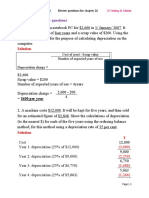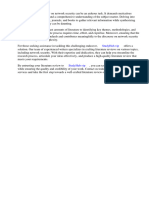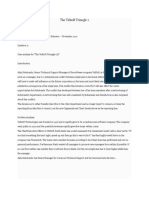Ass 1
Ass 1
Uploaded by
Huda AlMuhaizaCopyright:
Available Formats
Ass 1
Ass 1
Uploaded by
Huda AlMuhaizaCopyright
Available Formats
Share this document
Did you find this document useful?
Is this content inappropriate?
Copyright:
Available Formats
Ass 1
Ass 1
Uploaded by
Huda AlMuhaizaCopyright:
Available Formats
3. Research has found strong evidence that heredity has a strong influence on an individuals personality.
What are the implications of this in organizational settings? First, the strong effect of heredity suggests that applicant selection is an important way to improve job perform ance and employee wellbeing (by ensuring their work matches their personality). Although we might try to cha nge an employees style of behavior, their inherent style is strongly determined already. This is why many comp anies refer to hire e for attitude, train for skill A second implication is that training for some types of behavior might be less successful than employer assume. It would be better to transfer people into jobs that more closely match their personality. 5.An important aspect of self-concept is the idea that almost everyone engages in self-enhancement. What problems tend to occur in organizations as a result of this self-enhancement phenomenon? What can organizational leaders do to make use of a persons inherent drive for self-enhancement? Selfenhancement causes managers to overestimate the probability of successful in investment decisions, such as acquiring another company, perceptual biases (less likely to notice problems), competition with other emploeeys, and morale and motivation problems (not everybody is above average!). The second question disscus how can we make people feel good aboutthemselves at work in ways that motivates them and improves their wellbeing? One suggestion might be person job fit put employees in jobs for which they are qualified and enjoy the type of work activity. Another idea is to focus on the employees strengths, rather than shortcomings, in performance feedback. Leadership style is a third approach. Great leaders treat every employee as an individual; when they interact with people, they treat that person as the focus of their attention. 8. All decisions are ethical decisions. Comment on this statement, particularly by referring to the concepts of moral intensity and ethical sensitivity.This sweeping statement is false. For a decision to have an ethical di mension it has to have some moral intensity associated with it. Moral intensity is a characteristic of the situa tion. It refers to the degree to which an issue demands the application of ethical principles. Who should be l aid off ? Would have high moral intensity. On the other hand, a decision to take an umbrella to work because it might rain has no moral intensity. This is because morally intense issues involve others in the society who may think the decision is good or evil, or the issue quickly affects people. Ethical sensitivity refers to a characteristic of the decision maker, not the situation. Faced with the same issue, Two decision makers may be more or less ethically sensitive. This means that people differ in their ability to recognize the presence and determine the relative importance of an ethical issue. Moral intensity and ethical sensitivity are different. An issue with high moral intensity might be decided without the required ethical consideration because the decision maker doesnt recognize its ethical importance (i.e., the person has low ethical sensitivity). Thus, both concepts are important factors in the extent to which we apply ethical principles to issues.
Case Questions Answers 1. In an organizations efforts to maintain ethical standards, how important is it to encourage and support employees who report possible incidents of ethical wrongdoing (i.e. engage in whistleblowing)? Why? What can companies do to support whistleblowers? It is VERY important to support whistleblowing. The reasoning is that whistleblowers reveal wrongdoing close to them, so they typically have factual information that is not easily received otherwise. Whistleblowers are Often the only means by which serious wrongdoing becomes known to people outside that inner circle, at least until long after the wrongful acts have been committed. follow usual channels of complaint before taking the matter to the public or outside authority. Of course, there are times when the inside channels are not appropriate (e.g. the insiders are engaging in the wrongdoing), but there is also a risk that a company receives damaging publicity from whistleblowing before it has been given the opportunity to solve the problem. But also note that, as in this case, whistleblowing including the practice of informing authorities within the organization. Companies can support whistleblowers by providing clear guarantees regarding the rights of whistleblowers to have their jobs protected or reasonable severance where continued employment is not possible. Furthermore, companies need to provide a clear route and set of procedures for people to follow so their information is received by people in positions of power who have no affiliation with the wrongdoing. Third, companies need to develop procedures, un like the example at WalMart where whistleblowers remain anonymous to the extent that this anonymity is possible. 2. What actions are described in this case study that companies have applied to improve ethical standards in their organizations? Are these substantive changes, more mostly symbolic? Why? The case study describes how companies have hired chief ethics officers to oversee the development of ethics programs and practices. Companies have also introduced and annually reinforce a code of conduct. The question of whether these are significant or symbolic depends on the organization. some of these companies take ethical conduct, particularly employee reports of wrongdoing.
You might also like
- Step 1:: CXO CXWDocument5 pagesStep 1:: CXO CXWRasheed Rick AmoresNo ratings yet
- Yarra Bend AsylumDocument11 pagesYarra Bend AsylumHelena KhouryNo ratings yet
- AisDocument2 pagesAisMarga Castillo100% (5)
- Practice Problems: Measures of Central TendencyDocument6 pagesPractice Problems: Measures of Central Tendencygazer beamNo ratings yet
- Problems 1Document4 pagesProblems 1vishwajeetg50% (2)
- Inventory AnnotatedDocument90 pagesInventory AnnotatedlaithNo ratings yet
- Competitivenes AssignmentDocument3 pagesCompetitivenes AssignmentTristan Zambale100% (1)
- Part One Principles and Practices: Chapter ObjectivesDocument13 pagesPart One Principles and Practices: Chapter ObjectivesFernando Elías Valderrama GómezNo ratings yet
- Product Cost Vs Period CostDocument3 pagesProduct Cost Vs Period CostIram GulNo ratings yet
- Retail Assignment RenzJanuaryDocument3 pagesRetail Assignment RenzJanuaryHoneyPotGameing d (HoneyPotGaming)No ratings yet
- Prime Cost, Conversion Cost and Carrying CostDocument4 pagesPrime Cost, Conversion Cost and Carrying CostIris YangNo ratings yet
- Let's Check: Mentioned in The Essential Knowledge Part of This UnitDocument3 pagesLet's Check: Mentioned in The Essential Knowledge Part of This UnitChang DrilonNo ratings yet
- 4-The Cost Accounting CycleDocument17 pages4-The Cost Accounting CycleHinazeeshan MalikNo ratings yet
- Midterm Exam - An Inventor For A Day - What Can Change The WorldDocument4 pagesMidterm Exam - An Inventor For A Day - What Can Change The WorldMikko LaurenNo ratings yet
- Chap 3Document30 pagesChap 3Thiru VenkatNo ratings yet
- QuestionsDocument8 pagesQuestionsHannah AbeloNo ratings yet
- Obligations and Contracts Chapter 1: General ProvisionDocument2 pagesObligations and Contracts Chapter 1: General ProvisionGlomar BedsheetNo ratings yet
- Group 7 Group AssignmentDocument16 pagesGroup 7 Group AssignmentAZLINDA MOHD NADZRINo ratings yet
- Dressing Up or Down For WorkDocument11 pagesDressing Up or Down For WorksayaganasNo ratings yet
- Ch.9 Cost AnalysisDocument29 pagesCh.9 Cost AnalysisWinnydetuo WinwinNo ratings yet
- Application LetterDocument21 pagesApplication Letternova simanjuntakNo ratings yet
- Standard Costing and Its Role in Today's Manufacturing EnvironmentDocument10 pagesStandard Costing and Its Role in Today's Manufacturing Environmentsuraj5726100% (2)
- Paradigm DefinitionDocument7 pagesParadigm Definitionkr-sanjiv002No ratings yet
- Chapter 4 ExerciseDocument2 pagesChapter 4 ExerciseMatt MoralesNo ratings yet
- Chapter 5 SM HeheDocument9 pagesChapter 5 SM HeheMaricel De la CruzNo ratings yet
- ACTIVITY 7.3 Unit Reflection - CarreonAndrewG.Document2 pagesACTIVITY 7.3 Unit Reflection - CarreonAndrewG.Andrew CarreonNo ratings yet
- Friendly Assisted Living Facility UpdateDocument5 pagesFriendly Assisted Living Facility UpdateCream FamilyNo ratings yet
- Strategic Management PaperDocument3 pagesStrategic Management PaperRo-Anne De CastroNo ratings yet
- Forecasting: Types of Forecasting ModelsDocument8 pagesForecasting: Types of Forecasting Modelslovely abinalNo ratings yet
- Traditional Accounting System VsDocument9 pagesTraditional Accounting System VsErra PeñafloridaNo ratings yet
- Unit 1. Quality, Total Quality, TQMDocument29 pagesUnit 1. Quality, Total Quality, TQMsbmallur100% (2)
- Chapter 26 - Review QuestionsDocument7 pagesChapter 26 - Review QuestionsAli MohamedNo ratings yet
- Chapter 16 - Securities Firms and Investment BanksDocument2 pagesChapter 16 - Securities Firms and Investment Banksmvlg26No ratings yet
- Auditibg Problems Purchase CommitmentDocument1 pageAuditibg Problems Purchase Commitmentnivea gumayagay0% (1)
- Economic Order Quantity - Examples - Formula - QuestionsDocument35 pagesEconomic Order Quantity - Examples - Formula - QuestionsahmedNo ratings yet
- Lecture-7 Overhead (Part 4)Document38 pagesLecture-7 Overhead (Part 4)Nazmul-Hassan SumonNo ratings yet
- Chapter 2: Auditing It Governance ControlsDocument36 pagesChapter 2: Auditing It Governance ControlsKino Marinay100% (1)
- Ms14e Case Chapter 03 FinalDocument10 pagesMs14e Case Chapter 03 FinalOfelia Ragpa100% (1)
- Chapter 1 TQM Evolution Ppt2Document33 pagesChapter 1 TQM Evolution Ppt2MALLIKARJUNNo ratings yet
- Pentacapital V MahinayDocument3 pagesPentacapital V MahinayHector Mayel Macapagal0% (1)
- Materi UAS Engineering Ethical CasesDocument3 pagesMateri UAS Engineering Ethical Casesdhisaa50% (4)
- Case One PepsiCo Implements New Procurement SystemDocument2 pagesCase One PepsiCo Implements New Procurement SystemLeila HuiNo ratings yet
- Departmentalized Factory OverheadDocument10 pagesDepartmentalized Factory Overheadhae1234No ratings yet
- Problem 1Document4 pagesProblem 1RexmarNo ratings yet
- Cost and Management Accounting - Tugas 4 - 10 SEP FIXDocument3 pagesCost and Management Accounting - Tugas 4 - 10 SEP FIXAlfiyanNo ratings yet
- Chapter 27 - Answer PDFDocument22 pagesChapter 27 - Answer PDFRafael Renz DayaoNo ratings yet
- Philia: Love Sophia: Wisdom "The Love of Wisdom: Business Logic PhilosophyDocument9 pagesPhilia: Love Sophia: Wisdom "The Love of Wisdom: Business Logic PhilosophyClarise Satentes AquinoNo ratings yet
- Acc 14 FinalDocument7 pagesAcc 14 FinalKiaNo ratings yet
- I. Learning Activities: Sum of Weights (3+2+1) 6Document6 pagesI. Learning Activities: Sum of Weights (3+2+1) 6Valdez AlyssaNo ratings yet
- Rizal Answer SheetDocument8 pagesRizal Answer SheetJohn Rey BandongNo ratings yet
- Individual FactorsDocument14 pagesIndividual FactorsshahidNo ratings yet
- Praktiker ThesisDocument5 pagesPraktiker Thesis1238912No ratings yet
- Activity Based Costing - An IntroductionDocument40 pagesActivity Based Costing - An IntroductionNitish ShahNo ratings yet
- Saad Karimi (Assignment 1)Document10 pagesSaad Karimi (Assignment 1)pakistan50% (2)
- Auditing: Types of AuditDocument43 pagesAuditing: Types of Auditjohn paolo josonNo ratings yet
- Or Lectures 2011 - Part 1Document196 pagesOr Lectures 2011 - Part 1Ahmed Ramadan100% (1)
- Pricing and Costing Final Examination Key To CorrectionDocument8 pagesPricing and Costing Final Examination Key To CorrectionSherwin Francis MendozaNo ratings yet
- Intermediate Accounting1 PDFDocument7 pagesIntermediate Accounting1 PDFTangent Pcs100% (1)
- Ethics, Justice, and Fair Treatment in Human Resource ManagementDocument32 pagesEthics, Justice, and Fair Treatment in Human Resource ManagementPromiti SarkerNo ratings yet
- Business Ethics Notes PersonalDocument12 pagesBusiness Ethics Notes PersonalRuta PadhyeNo ratings yet
- Business Ethics NotesDocument12 pagesBusiness Ethics NotesEVA MAQUILLANo ratings yet
- Psychology: Discipline and Ideas in Social SciencesDocument20 pagesPsychology: Discipline and Ideas in Social SciencesJulie Ann EstradaNo ratings yet
- Assessment For ParentsDocument5 pagesAssessment For ParentsNilima NarangNo ratings yet
- Family Observation PresentationDocument9 pagesFamily Observation PresentationfarrahNo ratings yet
- A Continuum of Play Based Learning The Role of The Teacher in Play Based Pedagogy and The Fear of Hijacking PlayDocument17 pagesA Continuum of Play Based Learning The Role of The Teacher in Play Based Pedagogy and The Fear of Hijacking PlayMd Delowar Hossain MithuNo ratings yet
- Chapter 8 - Sullivan Learning PlanDocument3 pagesChapter 8 - Sullivan Learning PlanhitoNo ratings yet
- Agency Theory, Performance Evaluation, and The Hypothetical Construct of Intrinsic MotivationDocument21 pagesAgency Theory, Performance Evaluation, and The Hypothetical Construct of Intrinsic Motivationapi-3698791100% (1)
- Bloom's Taxonomy - Center For Innovative Teaching and Learning - Northern Illinois UniversityDocument5 pagesBloom's Taxonomy - Center For Innovative Teaching and Learning - Northern Illinois UniversityDr. M. Hannan JamilNo ratings yet
- Design and Development of Physics Module Based On Learning Style and Appropriate Technology by Employing Isman Instructional Design Model PDFDocument10 pagesDesign and Development of Physics Module Based On Learning Style and Appropriate Technology by Employing Isman Instructional Design Model PDFSarlita NugrahaNo ratings yet
- MetaparadigmDocument6 pagesMetaparadigmBuklatin Lyra Elghielyn H.No ratings yet
- Theory Evaluation PaperDocument5 pagesTheory Evaluation PapercaitydidNo ratings yet
- Literature Review Network SecurityDocument8 pagesLiterature Review Network Securityc5q8g5tz100% (1)
- Concept and Goals of PEDocument50 pagesConcept and Goals of PEJohanamhy PanergoNo ratings yet
- Personal Finance Syllabus Kayla WainwrightDocument5 pagesPersonal Finance Syllabus Kayla Wainwrightapi-305328731No ratings yet
- The Vidsoft TriangleDocument3 pagesThe Vidsoft TriangleEnver KerqeliNo ratings yet
- Reflection On The Impacts of Shifting Cultural MdenizDocument4 pagesReflection On The Impacts of Shifting Cultural Mdenizapi-273275279No ratings yet
- Every Mind Matters Bullying and Cyberbullying Lesson Plan KS34Document5 pagesEvery Mind Matters Bullying and Cyberbullying Lesson Plan KS34Sadık ÇalışkanNo ratings yet
- Compatibility of INTJ With INFP in Relationships TruityDocument1 pageCompatibility of INTJ With INFP in Relationships TruityJoseph LeonNo ratings yet
- Matt ResumeDocument2 pagesMatt Resumeapi-527736346No ratings yet
- Gebhard Models of SupervisionDocument8 pagesGebhard Models of SupervisionBritishCouncilAlgeriaNo ratings yet
- Tieng Anh 10 Friends Global - Unit 1 - Test 1Document4 pagesTieng Anh 10 Friends Global - Unit 1 - Test 1btphuong71No ratings yet
- The Resilient Child: How Trauma Impacts A ChildDocument63 pagesThe Resilient Child: How Trauma Impacts A ChildLuo LesterNo ratings yet
- Boyd 2014Document7 pagesBoyd 2014Merlynde OrtizNo ratings yet
- Basketball Training For Speed Agility and QuicknessDocument6 pagesBasketball Training For Speed Agility and QuicknessAlbert StoneNo ratings yet
- Chapter 4 Buyer's BehaviourDocument17 pagesChapter 4 Buyer's BehaviourShreeshabNo ratings yet
- PHD Dissertation Topics in LinguisticsDocument4 pagesPHD Dissertation Topics in LinguisticsDoMyPaperEvansville100% (1)
- Lesson 3 - Career Interview-Job Shadow ReflectionDocument1 pageLesson 3 - Career Interview-Job Shadow Reflectionapi-456827469No ratings yet
- Here 142Document142 pagesHere 142DiegoNo ratings yet
- Variations in AttributesDocument3 pagesVariations in AttributesnihalNo ratings yet
- Undertsanding The Self Complete Module 1Document135 pagesUndertsanding The Self Complete Module 1Alhaina JulkanainNo ratings yet

























































































